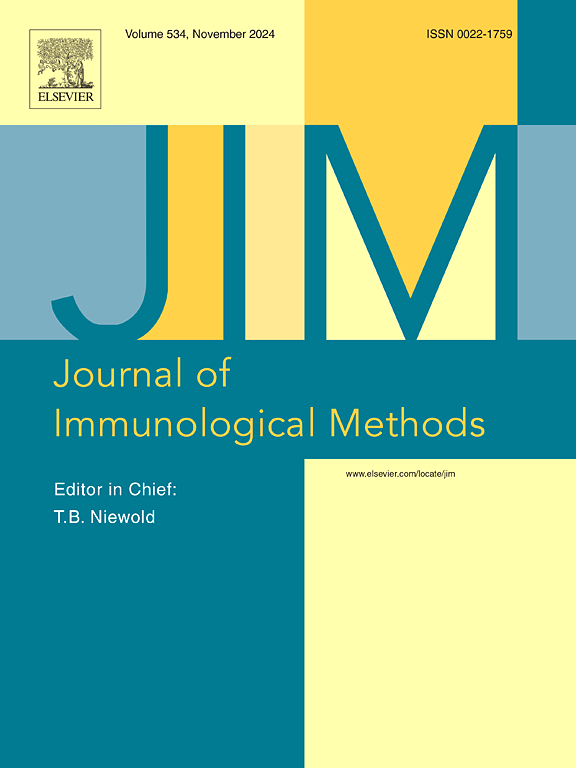Development of a novel histidine-rich glycoprotein measurement system as a biomarker for sepsis
IF 1.6
4区 医学
Q4 BIOCHEMICAL RESEARCH METHODS
引用次数: 0
Abstract
The plasma histidine-rich glycoprotein concentration is a marker of sepsis severity. In this study, we generated selective and specific monoclonal antibodies against histidine-rich glycoprotein for use in a prototype enzyme-linked immunosorbent assay-based in vitro diagnostic system. First, we investigated the properties of monoclonal antibodies produced by 21 hybridomas that we developed using immunized mice, and we identified monoclonal antibodies 69-1A and 75-2D to be the most suitable combination for use in the sandwich enzyme-linked immunosorbent assay. Wild-type histidine-rich glycoprotein (Form-1, 75 kDa) with a proline residue at amino acid position 204 is the most common isoform of the protein in humans, followed by its variant (Form-2, 77 kDa), which has a serine residue at position 204.
The epitope mapping was examined for the HRG amino acid sequence with 69-1A and 75-2D mAbs to achieve the identification of respective specific binding domains, though the other kinds of mAbs showed considerably complex domains. The identified epitopes recognized by 69-1A and 75-2D monoclonal antibodies did not span position 204. Furthermore, immunoprecipitation-immunoblotting analysis showed that the 69-1A and 75-2D monoclonal antibodies could bind to both Form-1 and Form-2 in human plasma samples. Thus, these two new antibodies can be used to clearly detect both forms of histidine-rich glycoproteins in human plasma samples. In our analysis of clinical samples by enzyme-linked immunosorbent assays using various combinations of our newly synthesized antibodies, we found that the histidine-rich glycoprotein concentration was significantly lower in plasma samples from septic patients than in those from healthy volunteers (p < 0.01). Thus, our novel analysis system using the new antibodies is expected to be a useful tool for sepsis research, and it may be adapted as an in vitro diagnostic tool for many other kinds of diseases in the future.
开发一种新的富组氨酸糖蛋白测量系统作为败血症的生物标志物
血浆富组氨酸糖蛋白浓度是脓毒症严重程度的标志。在这项研究中,我们生成了针对富组氨酸糖蛋白的选择性和特异性单克隆抗体,用于基于酶联免疫吸附试验的原型体外诊断系统。首先,我们研究了用免疫小鼠培养的21种杂交瘤产生的单克隆抗体的性质,我们确定了69-1A和75-2D单克隆抗体是最适合用于三明治酶联免疫吸附试验的组合。富含组氨酸的野生型糖蛋白(Form-1, 75 kDa)在204个氨基酸位置有脯氨酸残基,是人类中最常见的蛋白质异构体,其次是其变体(Form-2, 77 kDa),在204个位置有丝氨酸残基。我们用69-1A和75-2D单克隆抗体对HRG氨基酸序列进行表位定位,以确定各自的特异性结合域,尽管其他单克隆抗体的结构域相当复杂。69-1A和75-2D单克隆抗体识别的表位不跨越位置204。此外,免疫沉淀-免疫印迹分析表明,69-1A和75-2D单克隆抗体可以与人血浆样品中的Form-1和Form-2结合。因此,这两种新抗体可用于清晰地检测人血浆样品中两种形式的富组氨酸糖蛋白。在我们用酶联免疫吸附法分析临床样本时,我们发现脓毒症患者血浆样本中富含组氨酸的糖蛋白浓度明显低于健康志愿者(p <;0.01)。因此,我们使用新抗体的新型分析系统有望成为脓毒症研究的有用工具,并可能在未来成为许多其他疾病的体外诊断工具。
本文章由计算机程序翻译,如有差异,请以英文原文为准。
求助全文
约1分钟内获得全文
求助全文
来源期刊
CiteScore
4.10
自引率
0.00%
发文量
120
审稿时长
3 months
期刊介绍:
The Journal of Immunological Methods is devoted to covering techniques for: (1) Quantitating and detecting antibodies and/or antigens. (2) Purifying immunoglobulins, lymphokines and other molecules of the immune system. (3) Isolating antigens and other substances important in immunological processes. (4) Labelling antigens and antibodies. (5) Localizing antigens and/or antibodies in tissues and cells. (6) Detecting, and fractionating immunocompetent cells. (7) Assaying for cellular immunity. (8) Documenting cell-cell interactions. (9) Initiating immunity and unresponsiveness. (10) Transplanting tissues. (11) Studying items closely related to immunity such as complement, reticuloendothelial system and others. (12) Molecular techniques for studying immune cells and their receptors. (13) Imaging of the immune system. (14) Methods for production or their fragments in eukaryotic and prokaryotic cells.
In addition the journal will publish articles on novel methods for analysing the organization, structure and expression of genes for immunologically important molecules such as immunoglobulins, T cell receptors and accessory molecules involved in antigen recognition, processing and presentation. Submitted full length manuscripts should describe new methods of broad applicability to immunology and not simply the application of an established method to a particular substance - although papers describing such applications may be considered for publication as a short Technical Note. Review articles will also be published by the Journal of Immunological Methods. In general these manuscripts are by solicitation however anyone interested in submitting a review can contact the Reviews Editor and provide an outline of the proposed review.

 求助内容:
求助内容: 应助结果提醒方式:
应助结果提醒方式:


